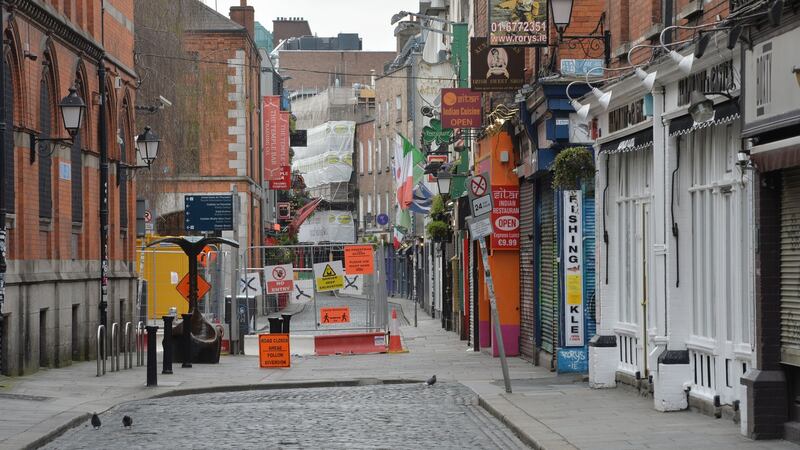What does a 15-minute city really look like? How can we learn from some of the positive aspects of the impact of the pandemic on urban and suburban life? How do we make Dublin liveable again?
I’ve spent the past month in Paris, where the 15-minute city concept – inspired by Jane Jacobs via Carlos Moreno and popularised by Paris mayor Anne Hidalgo – has been developed and subsequently seized upon by other towns and cities as offering a way forward, or more often as a way to just sound progressive or innovative.
Comparing cities can be tiresome, reductive and impractical. A lot of people cite Berlin as a good example to follow. I spend a lot of time there, and love the place. But Berlin as we know it came into being after much of it was flattened during the second World War. The reason the 15-minute city concept was so perfect for Paris is because, in so many ways, Paris already was one. In many north American cities, the idea of most things you need – a home, work, commerce, culture and entertainment, healthcare, education – being accessible within a 15-minute walk or cycle sounds completely radical and unattainable because so many cities were gutted by car culture, racist planning and housing policies, suburban sprawl, and the decentralisation of shopping and amenities.

Every city’s context is unique. However, while unique contexts cannot be transferred from one jurisdiction to another, ideas can. So what about Dublin? The city has fallen victim to the kind of intensely stupid planning and development that now pockmarks many English cities. Places that once had character have been spoiled by soulless corporate gentrification. Liverpool, for example, has recently lost its Unesco world heritage status, due to stupid development stripping the historical value of its Victorian docks.
Planning errors
Dublin is sometimes described as a Georgian city with a medieval core. But we know that’s not true in real terms when it comes to city life. Dublin has former Georgian housing renovated as offices (all empty during the pandemic), with small parks that close in the evening. Its medieval core is being stripped of its character, primarily by one of the gravest planning errors the city has made in recent years, the combination of unwanted luxury student accommodation (some now being converted to short-term lets) and excessive hotel-building.
The city has fallen victim to the intensely stupid planning and development that pockmarks many English cities
During the pandemic, it became clear that Dublin City Council primarily views the city as a commercial district with a large tourist element, and not a living place. What the Irish capital needs to focus on is resisting the aesthetic terror of making everything look like a new terminal at Gatwick airport, and focus on vibrant street life, walkability, amenities, public space, lively commerce and culture. It needs to become a place where density is a pleasant experience, and where proximity breeds vibrancy. Leaving aside the housing crisis, the construction of homogeneous apartment developments – that become soulless dead zones butting up against the character of the city – is something we need to halt. It’s not about “stock” or “units”, it’s about life.
Way forward
Here are 10 quick and cheap ideas for Dublin to become revitalised and more pleasant.
1. Put retractable awnings on every street where there is outdoor space to create a culture where hanging out in all weather is something that’s possible.
2. Revitalise laneways by giving them to the communities that exist around them for social and cultural use.
3. “Meanwhile use” should also cover wasteland and derelict land, where if a site is vacant for six months, the council is compelled to turn it into public space, even if that’s just temporary.
4. New developments must include large community gardens where food is shared via a co-operative.
5. There are still retail units and impractical office units in the city that haven’t been filled since the Celtic Tiger era, so we need to introduce change-of-use rules where culture-first and community-first ideas compel their owners to free up the space with that as a first-option criteria.
Where I live in Dublin 7, teenagers mostly hang out on wasteland. What does that say about how we value young people in the city centre?
6. Focus on public space for teenagers. In Paris, I’ve noticed that public seating is not just limited to the endless individual chairs in parks, or the countless benches in every public area, but also large wooden decking-like spaces, where teenagers can sit and socialise in groups. This is cheap and pleasant. Where I live in Dublin 7, teenagers mostly hang out on wasteland. What does that say about how we value young people in the city centre? We need more skateparks, more bike parks, and more safe and fun hangout space for teenagers.
7. Scrap the ridiculous and unwanted white-water rafting “plan” for Dublin’s docks, and instead build large outdoor public swimming facilities. This is much cheaper and much more accessible.
8. Reopen and build more public toilets and introduce public seating every 20m in the city.
9. Scrap the idea of underground transport and expand the tram network and cycle lanes. We are moving away from a commuter-based society, and the idea of shoving people out of a city and then pulling them into it every morning in traffic is ridiculous.
10. Allow public barbecuing and scrap the bylaws that make public drinking illegal.
So there you go, you’ve now saved money and made loads of people happy. These ideas would serve people, not corporate developers. So whose side are we on?









